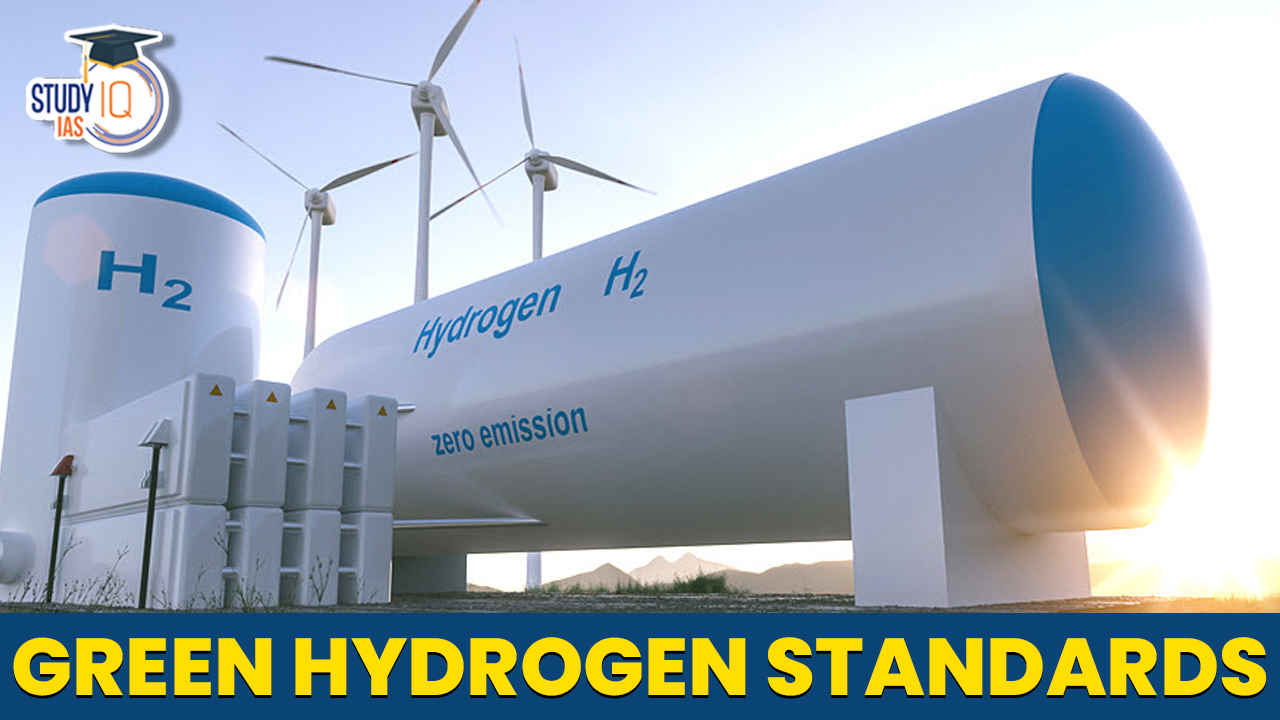Table of Contents
Context: The government has notified the Green Hydrogen Standard for India, for the progress of the National Green Hydrogen Mission.
More on News
- The Green Hydrogen Standard for India has been issued by the Ministry of New and Renewable Energy (MNRE).
Key specifications under Green Hydrogen Standard
- Emission Threshold: The standard sets a specific emission threshold that hydrogen production processes must adhere to in order to be classified as “Green” hydrogen. The well-to-gate emission, which includes various stages of hydrogen production (such as water treatment, electrolysis, gas purification, drying, and compression), should not exceed 2 kg CO2 equivalent per kg of hydrogen produced.
- Scope: The definition of “Green” hydrogen covers hydrogen production methods using both electrolysis-based and biomass-based techniques. This means that the emission threshold applies to hydrogen produced through these methods as long as they meet the specified emission criteria.
- Methodology: The notification states that a detailed methodology for the measurement, reporting, monitoring, on-site verification, and certification of green hydrogen and its derivatives will be specified by the Ministry of New & Renewable Energy. This ensures that the emission calculation and verification processes are standardized and consistent.
- Nodal Authority: The Bureau of Energy Efficiency (BEE), under the Ministry of Power, is designated as the Nodal Authority for accrediting agencies responsible for monitoring, verification, and certification of Green Hydrogen production projects. This ensures proper oversight and compliance with the emission standards.
- Global Significance: With the introduction of this standard, India becomes one of the early adopters to formally define “Green” hydrogen and set emission standards for its production. This move aligns with global efforts to promote sustainable and low-carbon hydrogen production methods.
- The Green Hydrogen Standard for India represents a significant step towards promoting sustainable and environmentally friendly hydrogen production, supporting the goals of the National Green Hydrogen Mission, and contributing to India’s efforts to mitigate climate change and transition to cleaner energy sources.

About Hydrogen
- It is a colourless, odourless, tasteless, non-toxic and highly combustible gaseous substance.
- Also, it is the lightest, simplest and most abundant member of the family of chemical elements in the universe.
- While hydrogen is not typically found in its pure form on Earth, it is commonly found in compounds such as water (H2O) and hydrocarbons.
What is Green Hydrogen?
- Depending on the type of production used, different colours are assigned to the hydrogen.
- Green hydrogen is produced by renewable energy through electrolysis of water. Electrolyser technology is central to the green hydrogen production process.
- Electrolysis involves the splitting of water (H2O) into its constituent elements, hydrogen (H2) and oxygen (O2), using an electric current.
- Commercially available technologies for green hydrogen production:
- Alkaline Electrolyzers: Alkaline electrolyzers operate via transport of hydroxide ions (OH-) through the electrolyte from the cathode to the anode with hydrogen being generated on the cathode side.
- Polymer Electrolyte Membrane Electrolysers: In a polymer electrolyte membrane (PEM) electrolyser, the electrolyte is a solid specialty plastic material.
- Solid Oxide Electrolyzers: It uses a solid ceramic material as the electrolyte that selectively conducts negatively charged oxygen ions (O2-) at elevated temperatures (700°–800°C) to generate hydrogen.
- Applications: Green hydrogen can be consumed through either direct combustion, electricity generation through fuel cells and industrial processes like ammonia, steel manufacturing and petroleum refinery to be used as chemical feedstock.
Advantages of Green Hydrogen as a fuel
- High Calorific Value: Hydrogen has almost 2.5 times the energy per tonne compared as to natural gas, shifting to Hydrogen thereby reduces natural gas imports.
- Energy efficiency: A hydrogen fuel cell is two to three times more efficient than an internal combustion engine fueled by gas.
- Climate change mitigation: The method of producing green hydrogen does not emit any greenhouse gases, helping in out fight against climate change.
- Also, Green hydrogen can potentially replace the coal and coke in iron and steel production, decarbonizing this sector will also have significant impact on India’s climate goals.
- Hydrogen can be effectively used as a fuel for heavy duty vehicles, helping in the decarbonization of transportation sector too.
- Storage: Hydrogen has the highest energy per mass of any fuel, which means that the higher the energy density of a system, the greater the amount of energy you can store.
- Cost effective: India’s distinct advantage in low-cost renewable electricity means that green hydrogen will emerge as the most cost-effective form.
- Grid stability: The intermittent nature of renewable energy, especially wind, leads to grid instability. But green hydrogen can be stored for long periods of time which can be used to produce electricity using fuel cells.
- Monetary benefits: Experts say the oxygen, produced as a by-product can also be monetized by using it for industrial and medical applications or for enriching the environment.
- Demand: It is expected that Hydrogen demand in India could grow more than fourfold by 2050, representing almost 10% of global demand of which majority of this demand could be met with green hydrogen.
Concerns with Green Hydrogen
- Transportation and Storage: Storage and transportation of hydrogen have traditionally been difficult due to the unique characteristics of the gas flammability, low density, ease of dispersion, and embrittlement.
- High cost: The cost of green hydrogen production is much higher than what is produced from fossil fuels, due to high prices of renewables and rare earth material used as electrodes.
- High energy consumption: The production of green hydrogen particular requires more energy than other fuels. Also, availability of renewable energy is not at par demand.
- Prone to leakages: Because gaseous hydrogen consists of such a small molecule, it is more prone to leakages throughout the value chain. Impacts of hydrogen fuel leak include:
- Aggravates global warming: When hydrogen leaks, it reacts with other greenhouse gases at the atmospheric level and increases their GWP (global warming potential). According to scientists, if 10% leaks during its production, transportation, storage, or use, the benefits of using green hydrogen over fossil fuels would be completely wiped out.
- Risk of fires: As a fuel, hydrogen is highly flammable and so hydrogen leaks generate a serious risk of fire.
- Asphyxiation: If leaked hydrogen accumulates in a confined space in sufficient concentrations it, like all other gasses except oxygen, is an asphyxiant.
About the National Green Hydrogen Mission
| Launch |
|
| Nodal agency |
|
| Outlay |
|
| Expected outcomes by 2030 |
|
| Key features of the mission |
|
| Benefits of the mission |
|
Implementation Challenges for Green Hydrogen Mission in India
- Cost barrier: The high cost of manufacturing green hydrogen using renewable energy is the most significant barrier to its adoption in India, accounting for around 65% of the entire cost.
- At present, in India, green hydrogen is not commercially viable. The current cost in India is around Rs 350-400 per kg; It is likely to become viable only at a production cost of under Rs 100/ kg.
- Insufficient Demand Incentives: The measures to boost demand for green hydrogen have not kept pace with the significant incentives provided for its supply, resulting in uncertainty for potential investors.
- Fluctuating Renewable Energy Supply: The usage of renewable energy in the grid can cause shifts in supply and demand, posing challenges for determining the real-time availability and pricing of renewable energy at green hydrogen locations.
- Inconsistent State Rules and Incentives: States lack clear rules defining incentives for green hydrogen plants, and investors are concerned about the continuity of renewable energy supply over the plant’s lifespan.
- Dependence on Limited Natural Resources (Water and Land):
- Water Requirement: Green hydrogen production relies heavily on water, with each kilogram of hydrogen requiring approximately 9 liters of demineralized water.
- Land Requirement: Setting up a typical green hydrogen facility generating 10 tonnes per day necessitates a substantial land area of around 750 acres for a 150 MW renewable energy plant.
Way Forward
- To overcome the above challenges:
- To reduce Green Hydrogen (GH2) costs, India needs consistent and low-cost renewable energy.
- India needs to invest in indigenous manufacture of Electrolysers and secure geo-political partnerships for procurement of critical minerals to overcome Electrolyser related challenges.
- Hydrogen hubs near demand centres can lower GH2 transportation costs.
- India must invest in sustainable water usage and utilize industrial/municipal wastewater or seawater for electrolysis.
- R&D is necessary to enhance Electrolysers’ efficiency, stack life, and reduce water and power requirements.
- To encourage exports, GH2 projects and RE plants may be eligible for tax and duty waivers.
- Encouraging State-Level Action and Policy Making: Promote and support state governments in implementing their own initiatives regarding Green Hydrogen, in addition to the national-level efforts.
- Support for MSMEs: Introduce incentives and support mechanisms at all levels to facilitate MSMEs harnessing the advantages of adopting Green Hydrogen as an alternative fuel.
- Capacity Building and Skill Development: Foster the development of knowledge and skills in the government, industry, and academia, focusing on Green Hydrogen adoption.
- Enhanced Coordination: Streamline coordination among different ministries and departments to expedite the mission’s implementation process.


 UPPSC Previous Year Question Papers, Dow...
UPPSC Previous Year Question Papers, Dow...
 Most Commonly Used Cancer Drugs and Thei...
Most Commonly Used Cancer Drugs and Thei...
 Tansen Biography, Musical Legacy and Mas...
Tansen Biography, Musical Legacy and Mas...





















